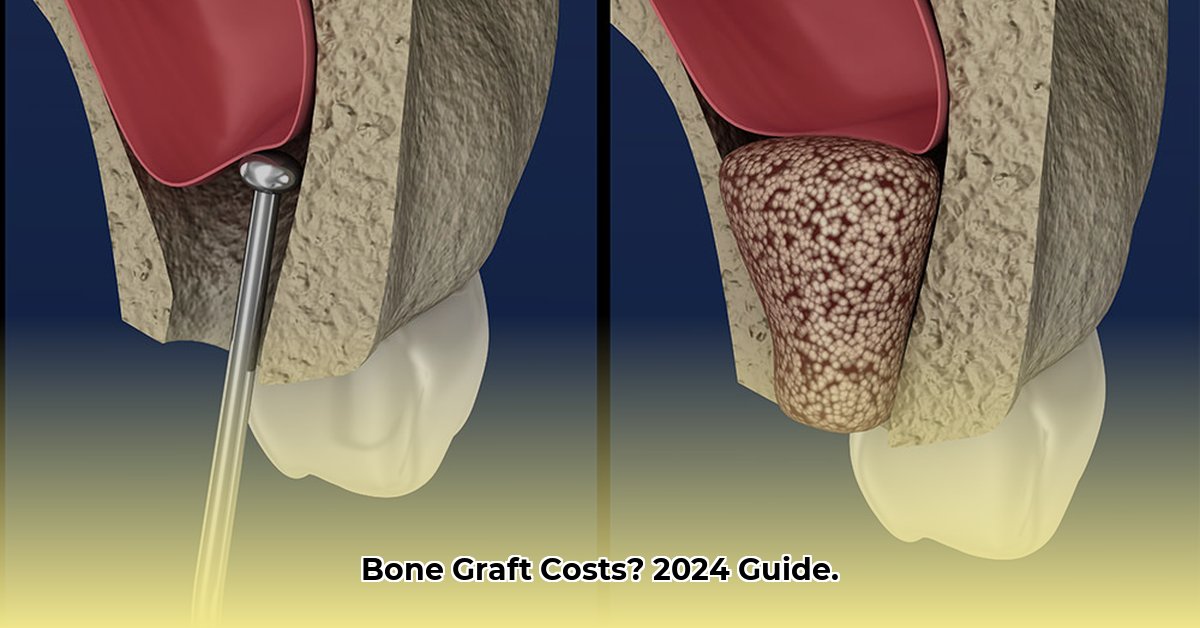Do You Need a Bone Graft?
A bone graft strengthens weakened jawbone, providing a solid base for teeth, implants, or dentures. Jawbone deterioration can stem from tooth loss, gum disease, or injury. If your dentist suggests a bone graft, it’s likely crucial for maintaining a healthy smile.
Bone Graft Options and Costs
Choosing the right graft involves weighing cost and effectiveness. Here’s a breakdown:
| Graft Type | Source | Estimated 2024 Cost Range | Pros | Cons |
|---|---|---|---|---|
| Autograft | Your own bone | $1,500 – $4,000+ (potentially higher) | Highest success rate, fully biocompatible | Requires a second surgical site, longer recovery |
| Allograft | Donor bone | $700 – $2,500 | Safe, readily available | Possibly slightly lower success rate, minimal rejection risk |
| Xenograft | Animal bone (usually cow) | $500 – $2,000 | Cost-effective, readily available | Slightly longer healing time, potential ethical concerns for some |
| Alloplast | Synthetic material | $300 – $1,500 | Least expensive, no second surgical site | May integrate slower, potential for complications |
These prices are estimates and can vary based on individual circumstances. Ongoing research suggests new techniques and materials may influence future pricing.
Factors Affecting Cost
Several factors contribute to the overall cost:
- Graft Type: Material costs vary significantly.
- Amount of Bone Needed: Larger grafts cost more.
- Location: Costs differ regionally due to varying overhead and market rates.
- Dentist’s Fees: Experience and specialization influence pricing.
- Additional Procedures: X-rays, CT scans, extractions, and sedation add to the total expense.
Average Cost Breakdown (2024 Estimates)
While the graft itself ranges from $300 to $4,000+ (with autografts being the most expensive), additional costs can include:
- X-rays: $20 – $250
- CT Scans: $600 – $1,000
- Initial Exams: $50 – $300
- Extractions: $75 – $650 per tooth
- Sedation: Varies depending on the type
Be sure to discuss all potential costs with your dentist for a personalized estimate.
Procedure and Recovery
Procedure: The graft material is placed in the deficient area under local anesthesia. Additional sedation may be available.
Recovery:
- Week 1: Expect swelling, discomfort, and a soft food diet.
- Weeks 2-4: Swelling subsides, discomfort eases, and diet can expand.
- Months 2-6: Healing progresses; follow-up appointments are necessary.
- 6+ Months: Bone integrates fully; implants may be considered.
Alternatives and Cost-Saving Strategies
Some cases may have alternative treatments like guided tissue regeneration or ridge augmentation.
Cost-saving strategies include:
- Insurance: Check your policy for coverage details.
- Dental Schools: Discounted services may be available.
- Payment Plans: Discuss financing options with your dentist.
Finding a Qualified Dentist
Seek a dentist specializing in bone grafting. Research their experience, certifications, and patient reviews. A thorough consultation should include a clear cost estimate.
FAQs
- Is a bone graft permanent? Bone grafts are generally long-lasting, though longevity can vary based on individual factors.
- Is the procedure painful? Local anesthesia prevents pain during the procedure. Some post-operative discomfort is manageable with over-the-counter medication.
- When can I get implants after a graft? Implant placement typically occurs after several months of healing, as determined by your dentist.
Disclaimer
This information is for educational purposes only and is not a substitute for professional medical advice. Always consult with your dentist.
- Bento Box Shopping Tips for Smart and Stylish Lunch Prep - December 14, 2025
- Bento Box Trays Streamline Restaurant Meal Presentation and Transport - December 13, 2025
- Plastic Bento Boxes Face Scrutiny Over Sustainability Impacts - December 11, 2025










